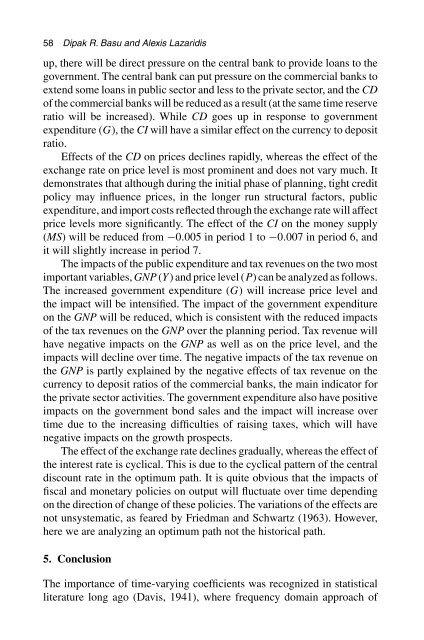Economic Models - Convex Optimization
Economic Models - Convex Optimization
Economic Models - Convex Optimization
You also want an ePaper? Increase the reach of your titles
YUMPU automatically turns print PDFs into web optimized ePapers that Google loves.
58 Dipak R. Basu and Alexis Lazaridis<br />
up, there will be direct pressure on the central bank to provide loans to the<br />
government. The central bank can put pressure on the commercial banks to<br />
extend some loans in public sector and less to the private sector, and the CD<br />
of the commercial banks will be reduced as a result (at the same time reserve<br />
ratio will be increased). While CD goes up in response to government<br />
expenditure (G), the CI will have a similar effect on the currency to deposit<br />
ratio.<br />
Effects of the CD on prices declines rapidly, whereas the effect of the<br />
exchange rate on price level is most prominent and does not vary much. It<br />
demonstrates that although during the initial phase of planning, tight credit<br />
policy may influence prices, in the longer run structural factors, public<br />
expenditure, and import costs reflected through the exchange rate will affect<br />
price levels more significantly. The effect of the CI on the money supply<br />
(MS) will be reduced from −0.005 in period 1 to −0.007 in period 6, and<br />
it will slightly increase in period 7.<br />
The impacts of the public expenditure and tax revenues on the two most<br />
important variables, GNP (Y) and price level (P) can be analyzed as follows.<br />
The increased government expenditure (G) will increase price level and<br />
the impact will be intensified. The impact of the government expenditure<br />
on the GNP will be reduced, which is consistent with the reduced impacts<br />
of the tax revenues on the GNP over the planning period. Tax revenue will<br />
have negative impacts on the GNP as well as on the price level, and the<br />
impacts will decline over time. The negative impacts of the tax revenue on<br />
the GNP is partly explained by the negative effects of tax revenue on the<br />
currency to deposit ratios of the commercial banks, the main indicator for<br />
the private sector activities. The government expenditure also have positive<br />
impacts on the government bond sales and the impact will increase over<br />
time due to the increasing difficulties of raising taxes, which will have<br />
negative impacts on the growth prospects.<br />
The effect of the exchange rate declines gradually, whereas the effect of<br />
the interest rate is cyclical. This is due to the cyclical pattern of the central<br />
discount rate in the optimum path. It is quite obvious that the impacts of<br />
fiscal and monetary policies on output will fluctuate over time depending<br />
on the direction of change of these policies. The variations of the effects are<br />
not unsystematic, as feared by Friedman and Schwartz (1963). However,<br />
here we are analyzing an optimum path not the historical path.<br />
5. Conclusion<br />
The importance of time-varying coefficients was recognized in statistical<br />
literature long ago (Davis, 1941), where frequency domain approach of
















